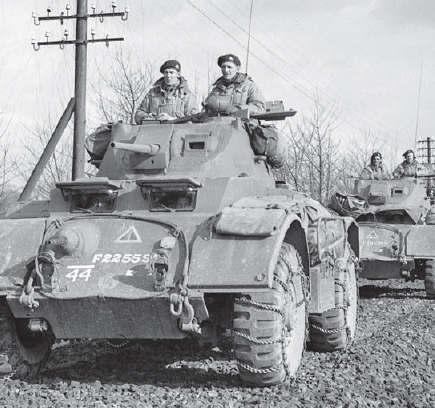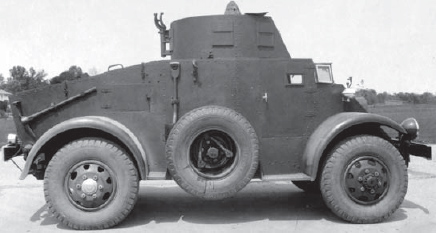
The Staghound medium armored car was a rarity among World War II US armored vehicles. It was one of the only American designs that was manufactured exclusively for other armies and never used by the US Army. The Chevrolet T17E1 was originally based on a joint US Armored Force and British requirement. By the time the T17E1 was ready for production, the US Army had ruthlessly restricted its armored car acquisition to a single type, the M8 light armored car. As a result, the Chevrolet M6 medium car never entered US service. However, British forces still saw a need for an armored car in this class and so encouraged serial production of the design, which they called the Staghound. The entire production run except for a handful of pilot models was supplied to Britain.

A column of Staghounds from A Squadron, XII Manitoba Dragoons, moves along a railroad bed in the Hochwald area of Germany on March 2, 1945. Tire chains are in use for traction in mud and the Staghounds have the usual Canadian bins added to the side in place of the auxiliary fuel drums. (NAC Jack Smith PA 144144)

The last significant armored car developed by the US Army prior to World War II was the archaic T11 developed by the Four Wheel Drive Auto Company in 1934–36. Six of the original T11s and six of the T11E1s were manufactured in 1934–35. Only this single pilot of the final T11E2 was completed, which incorporated a new turret. No serial production was authorized due to weak suspension and poor engine cooling. (NARA)
By the time the Staghound arrived in service in early 1944, battlefield conditions had changed. The vehicle was designed for long-range desert reconnaissance missions, but British and Commonwealth armored-car regiments were now knee-deep in the mud of the Italian winter. Although a dependable and robust vehicle, the Staghound was also large and cumbersome on Italy’s poor mountain roads. The Staghound fared better once the Italian campaign turned mobile in the summer of 1944. The vehicle was also widely used in North-West Europe starting in the summer of 1944, seeing service primarily in the headquarters of armored-car regiments. Its most extensive use was by Canadian regiments. The Staghound was durable and dependable enough that it remained in service after World War II. Many were cascaded down to NATO allies such as the Netherlands, Italy and Denmark, while others were exported to the countries in the Middle East. They saw combat use in several Middle Eastern wars, and remained in Lebanese service well into the 1980s. The Staghound continued to pop up in unexpected places around the globe, including Cuba during the revolution of the 1950s, and in Nicaragua during the civil war of the 1980s.